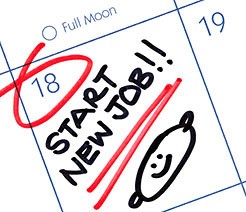
This blog post is provided by the Financial Planning Association.
As you look forward to starting a new job, it’s important to consider how you will manage your finances while making the transition from one employer to the next.
The checklist to use before starting a new job:
- Proactively manage your health insurance to avoid a lapse in coverage.
- Discuss dates with your old and new employers to assure continuous coverage.
- Check on the status of any pending claims under your old coverage.
- Arrange any needed transfers of records from your old insurer to your new insurer.
- Provide forwarding and contact information to the trustee of any health savings accounts (HSAs). If you expect to enroll in a high-deductible health plan at your new job, you can generally have any remaining balance in your HSA transferred, so you should determine what procedures you may need to follow. If you do not plan to enroll in a new high-deductible health plan, you can generally leave any HSA assets in your current plan and draw them down as needed for eligible future expenses.
If you have a flexible spending account (FSA) with your current employer, it’s important to pay attention to the details of the plan before you change jobs.
- A flexible spending account (FSA) lets you set aside a pretax portion of your paycheck to cover qualified medical expenses that would have otherwise come out of your pocket. Be sure to file all eligible expenses because, under current rules, you may only carry over up to $500 in unused funds to the next year.
- Prepare for your job change by submitting all eligible expenses for reimbursement under your old programs before you leave your current job, and check with your company’s HR department to find out whether or not you have a grace period for submission.
- Determine whether any future child care or commuting expenses may qualify for reimbursement from your old accounts.
Address important decisions about your future financial security by managing your retirement accounts.
- Evaluate all of the post-employment options for assets in your current plan — leave the assets in place, roll them over to an IRA, or roll them over to your new employer.
- Determine whether your old plan will require you to arrange a transfer within 60 days or get automatically cashed out, keeping in mind that cash-outs carry immediate tax consequences.
- Provide any necessary change-of-address information.
- Keep up your retirement savings efforts at your new employer.
Manage your employer-sponsored life and disability coverage.
- Determine the extent to which your new employer’s coverage might be a complete replacement for your existing coverage.
- Evaluate conversion options for existing coverage.
- Consider the need for individual disability insurance.
Keep records and receipts of any moving and transfer expenses for potential tax adjustments and reimbursements.
The checklist to use when you don’t have a job lined up:
Manage your health insurance.
- Determine the date for termination of coverage and look into extension and conversion options to avoid a lapse in coverage.
- Find out what kind of private individual and government-sponsored health insurance might be available in your area and evaluate your options.
- Check on the status of any pending claims.
- Track down copies of your insurance records.
- Provide forwarding and contact information to the trustee of any HSAs. Keep in mind that any remaining HSA balance should remain available to you for future eligible medical expenses, so you should determine what your plan procedures would be.
Manage your FSAs.
- Submit all eligible expenses for reimbursement before your departure, or confirm that you will have a grace period for submission.
Manage your retirement accounts.
- Evaluate the post-employment options for assets in your current plan — leaving the assets in place or rolling them over to an IRA.
- Determine whether your plan will require you to arrange a transfer within 60 days or get automatically cashed out, keeping in mind that cash-outs carry immediate tax consequences.
- Provide any necessary change-of-address information.
Manage your employer-sponsored life and disability coverage.
- Evaluate all conversion and replacement options for existing coverage.
Source/Disclaimer:
You have choices for what to do with your employer-sponsored retirement plan accounts. Depending on your financial circumstances, needs, and goals, you may choose to roll over your eligible savings to an IRA or convert to a Roth IRA, roll over an employer-sponsored plan from a prior employer to an employer-sponsored plan at your new employer, take a distribution, or leave the account where it is. Each choice may offer different investment options and services, fees and expenses, withdrawal options, required minimum distributions, tax treatment, and may provide different protection from creditors and legal judgments. These are complex choices and should be considered with care.
Required Attribution
Because of the possibility of human or mechanical error by DST Systems, Inc. or its sources, neither DST Systems, Inc. nor its sources guarantees the accuracy, adequacy, completeness or availability of any information and is not responsible for any errors or omissions or for the results obtained from the use of such information. In no event shall DST Systems, Inc. be liable for any indirect, special or consequential damages in connection with subscriber’s or others’ use of the content.
© 2016 DST Systems, Inc. Reproduction in whole or in part prohibited, except by permission. All rights reserved. Not responsible for any errors or omissions.

